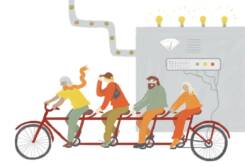Pension systems in different countries
The purpose of the pension system is to prepare for social risks common to all, irrespective of culture and country: longevity, disability, and the death of the family’s breadwinner However, these risks have been addressed in very different ways around the world.
Content of this page
Pension systems reviewed through division into pillars
Pension systems often differ markedly from country to country. Pension provision has been created from the premises of each individual country, and its principles are deeply rooted in the structures of each country’s economy, labour markets and culture on the whole.
An established international technique for examining pension arrangements and decision-making is to divide pension provision into pillars. The simplest practice is to have three pillars:
- statutory pension
- earnings-related pension based on employment
- private savings.
Division into pillars is a theoretical classification that provides a model for the nature of pension benefits. In practice, total income during the retirement years often consists of many pillar segments, but different pillars are emphasized in different ways. Also, different forms of pensions do not necessarily fit straight into the pillar structure. However, it is a traditional way of describing the organization of pension provision.
There are several different pillar classifications; for example, the OECD, the World Bank and the European Union all have their own classifications.
Finland’s earnings-related pension system in Pillar 1
Unlike many other countries, the Finnish earnings-related pension system is based on one strong social security pension pillar. For us, the national and guarantee pensions paid by Kela, and the earnings-related pension system are components of statutory social security.
In practice, the Finnish earnings-related pension system is a hybrid of Pillars 1 and 2: on the one hand, the social partners are involved in the governance of the pension system, as its owners and providers of funding, which is characteristic of Pillar 2 pensions. On the other hand, the earnings-related pension is an element of statutory social security, the laws of which are ultimately enacted by the Finnish Parliament.
As a whole, however, the Finnish earnings-related pension system is considered to be in Pillar 1, as our statutory pension includes both minimum security (guarantee and national pensions) and an earnings-related pension.
Falling under Pillar 1 is also affected by the fact that the Finnish earnings-related pension system is a non-profit, defined benefit system, mainly based on a pay-as-you-go scheme. In addition, the system is based on collective risk-sharing and includes the principle of joint and several liability for bankruptcy, and the so-called “principle of the last insurer”.
Occupational pensions play a significant role in many other countries
Since the earnings-related pension in Finland has provided comprehensive earnings-based pension insurance without a pension cap, i.e. maximum pension, employer-specific or trade-specific occupational pensions under the second pillar have played only a minor role in Finland. In many other countries, earnings-based pensions are employer-specific or trade-specific occupational pensions, i.e. often a party to labour market agreements or otherwise outside statutory social security. In this case, the statutory pension and the occupational pension based on employment are managed through different systems.
For example, in many European countries, these occupational pensions produce a considerable part of the earnings-based pension provision. The level and coverage of pension provision may vary depending on the occupational sector, the labour market status and organization. It is common to have shortcomings in pension coverage.
The role of private supplementary pensions, i.e. the third pillar, may be highlighted in situations where the level of pensions provided by the first and second pillars in relation to wages is low. Some degree of self-saving is common in Europe, for example, where supplementary pensions may be based on labour market agreements or have a voluntary basis. In the Finnish pension system, self-saved or occupational pensions play a role that complements statutory pension security.
Division into defined contribution and defined benefit systems
Depending on the way in which pensions are determined and financed, pension systems can be divided in a simplified manner into two categories: defined benefit and defined contribution systems.
In a defined benefit system, the benefit level is set beforehand or is determined on the basis of the earnings level and the length of the work history. This means predictable income for retirees. In order to cover pension expenses, the necessary earnings-related pension contributions are always collected from those currently in employment. These contributions are flexible as needed. Defined benefit plans are often pay-as-you-go plans, where the money for the payment of pensions is collected yearly. The defined benefit pension makes it possible to share the responsibility for the financial security of old age between people.
In a defined contribution system, the pension sum is determined on the basis of the total contributions paid into the system and the returns on investment received. In such cases, contributions are generally fixed and the benefit is flexible. Genuinely defined contribution systems tend to be funded, although they are rarely used for statutory occupational pensions. A fully funded, defined contribution pension transfers the investment risk to the unit itself.
The division into defined benefit and defined contribution plans is not necessarily very sharp; various hybrids, i.e. combinations of defined benefit and defined contribution plans, are increasingly common internationally.
The Finnish earnings-related pension system is a defined benefit system by nature, although in addition to the pay-as-you-go scheme, the Finnish model includes partial funding in the private sector as well as public-sector buffer funds. This is relatively rare in European social security pensions, for example.
Elsewhere in Europe, the trend with regard to earnings-related pensions is away from promised defined benefit pensions and towards defined contribution pensions. In these cases, investment risk is passed on to the individual and, at the same time, the cost risk, for instance, to public finances or companies decreases. Old-age income, however, may become less secure than in the Finnish model, where the pension level is known in advance.
Funding of pension assets at a high level in Finland
Funding and investing pension assets constitute an important element of the Finnish earnings-related pension system. Our earnings-related pensions are mainly financed by annual pension contributions, and in part by previously funded assets and the returns on their investments. For individuals, the level of the pension is not directly dependent on the development of investment returns.
Compared to other EU countries and at the global level, Finland has funded an exceptional amount of earnings-related pension contributions. Elsewhere, the funding of statutory pension schemes, and thus preparation for the future, are not equally high as they are for us.
The importance of investing pension assets elsewhere in Europe varies, depending on the pillar of the pension in question. Pillar 1 social security pensions are usually funded through a pay-as-you-go system, where assets for paying pensions are collected annually without any funding. In contrast, the investment of assets is common in Pillar 2 and 3 pensions.
Compared to other countries, Finland is doing quite well
When pension systems are compared, attention is often paid to the adequacy of pensions and the sustainability of financing. On both indicators, the Finnish model does fairly well in European and global comparisons. An earnings-related pension is the primary source of income for pensioners. Its purpose is to maintain a reasonable consumption level, while Kela’s guarantee pension and national pension provide a minimum income.
With respect to the financing of statutory earnings-related pensions, Finland is better prepared than many other European countries. The skewness of Finland’s age structure poses its own challenges to the financing of pensions, but Finland has also made more provisions for ageing of the population than most other EU countries by placing pension assets in funds. At present, Finland is leading the way in ageing, but many other countries will pass it in the future.
The returns on invested assets ease the pressure to raise pension contributions and serve as buffers for future pensions. Thus, pension contributions remain permanently lower than what they would be without funding.
In most other EU Member States, social security pensions do not include funding, and their costs are covered by taxes and fees collected annually. In the context of the economic crisis of the early 2010s, the sustainability of pension systems in many EU countries has been severely tested, especially as the population is ageing at the same time as life expectancies are rising. Under these financial pressures, pension systems have been revised in all countries, for example by raising retirement ages.
Finland will also need longer careers than at present in order to maintain the current level of pensions. The underlying factors are the increasing life expectancy and the rising target retirement age. For its own part, the earnings-related pension system supports longer work histories. In addition to the pension reforms carried out, rehabilitation has its own role within the earnings-related pension system. Its objective is to improve the opportunities to work when individuals can no longer continue at their former job for health reasons.

